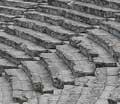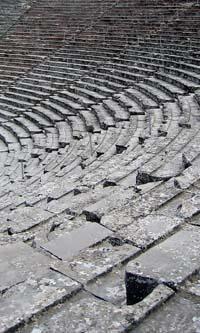Perfect theatre
2007/03/27 Roa Zubia, Guillermo - Elhuyar Zientzia

In the fourth century BC, the ancient Greeks built the perfect theatre: Epidaurus. In that theater, spectators who were sixty meters from the stage also heard the voices of the actors aloud and clear. How did they get it? Some American physicists have discovered that the theater was designed to absorb low sound frequencies, as the low frequencies are the ones that tend to listen well at a distance. Apart from these frequencies, the voices of the interpreters are heard from a distance, mainly by high frequencies. However, removing low frequencies (or attenuations) from the sound is not easy. The design of the theater, a structure of 34 rows, filters these frequencies and only allows the passage of high frequencies. When it is full of spectators, the effect is not the same and yet the acoustics remain good. Some physicists believe that the orientation of the theater also helps this effect, because the wind always goes from the stage to the seats. According to others, the plays themselves were suitable for performing in Epidaurus and in this type of theater, since the speech had a special rhythm. However, it is clear that theatre design is the key to quality. In this Epidaurus is especially good. Physicists do not know if it is the fruit of chance.

Gai honi buruzko eduki gehiago
Elhuyarrek garatutako teknologia





